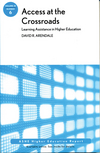
This blog focuses on my scholarship in my five research projects: learning assistance and equity programs, student peer study group programs, learning technologies, Universal Design for Learning, and history simulations. And occasional observations about life.
Creation, Conflict, and Survival: Life Lessons from a TRIO Program
“Creation, Conflict, and Survival” is a history story from several equity programs at the University of Minnesota that you might find useful. The co-authors are Bruce and Sharyn Schelske who directed a set of equity programs for over four decades that served historically-underrepresented and disadvantaged students. The story begins with the history of the Integrated Learning Course they created. The IL Course helped their students learn and practice learning strategies applied to a paired content course such as American History. In many ways, it operated as a mandatory SI-PASS-PAL program. But much more. Part two of the article is an extensive set of generic lessons from leading the IL course that could be used with any education program, not just the ones they led. My favorite is “Build your ark before the rain starts.” These life lessons are priceless.
You can download the article at https://hdl.handle.net/11299/241236 The original article that provides more description of the IL course and research studies that supported its effectiveness is available at https://hdl.handle.net/11299/200360
Best wishes to the start of another academic term.
Updated Peer Bibliography Directory and Individual Topics
From UnSplash
Today I uploaded the revised and expanded directory of peer study group programs. It expanded by over 100 entries in the past year. In addition, the topical bibliographies were updated and new categories were added for online programs, social media use, the technology employed during study sessions, and mention of facilitators or participants engaging in reflection during study sessions or outside of sessions by the facilitators as part of their personal and professional development. Among the options for downloading is one to download the EndNote data file of the entire database upon which all these bibliographies are based. All of this work is covered by a nonprofit copyright notice. You are encouraged to use these documents to support your program and be a resource for writing your own publications about peer learning programs. Simply go to the main menu tab for “resources” and then select “peer bibliography” from the drop-down menu.
Lilly, M., & Sands, J. (2019). Guide for Peer Learning Facilitators. University of Minnesota https://z.umn.edu/PALfacilitatorguide
The Guide for Peer Learning Facilitators is the foundation of a formal training program at the University of Minnesota, in which undergraduate students learn how to lead weekly study sessions for their peers in a classroom setting for specific courses – primarily ones with high enrollment and prone to higher than average D,F, Withdrawal rates. Training and professional development throughout the academic year have been the cornerstones to the success the facilitators have realized. The eight principles that govern the program – crafted by Dr. David Arendale in his original publication of the same name – address topics such as cooperative learning theory, multicultural competency, metacognition, study strategies, and group dynamics. The book, updated in April 2019, also provides a directory of useable forms and worksheets and a bibliography of related publications.
Benson, J., & Lilly, M. (2017). Peer-Assisted Learning Program: Guide for team leaders. University of Minnesota. https://z.umn.edu/PALleaderguide
The Guide for Team Leaders is designed to inspire personal exploration of leadership within PAL, SI, and related academic support programs. Depending on the program, there may already be an existing structure in place where an experienced facilitator/leader mentors their own team of peers functioning in a similar role. These team leaders can create opportunities for members to interact, share knowledge, and promote the professional growth of their peers.
This guide was originally designed to support the growth of such team leaders within the Peer-Assisted Learning (PAL) Program at the University of Minnesota. However, as this work progressed, it became clear that the ideas were applicable to a variety of team leadership roles. This hands-on guide delves into such topics as meta-cognition, team member identity and participation, meeting/discussion topics and activities, and much more. Interactive activities encourage readers to reflect on these topics, while providing ample space for them to record their insights. It complements the Guide for Peer Learning Facilitators and utilizes activities in Tried and Tweaked, both of which are works developed by the University of Minnesota’s PAL Program.
2018 Revised Annotated Bibliography of Postsecondary Peer Cooperative Learning Programs
 I am happy to announce that the 2018 Revised Annoated Bibliography of Postsecondary Peer Cooperative Learning Programs is now available to download. Click on this link for a PDF or Word version of it.
I am happy to announce that the 2018 Revised Annoated Bibliography of Postsecondary Peer Cooperative Learning Programs is now available to download. Click on this link for a PDF or Word version of it.
There are now nearly 1,500 entries spanning 488 pages. I noticed recent listserv conversations about locating research studies to support Supplemental Instruction programs or similar approaches operating at the college level. The directory grew significantly in the past two years. The directory includes the Emerging Scholars Program (Dr. Uri Treisman model), Peer-Led Team Learning, Supplemental Instruction, and Video-based Supplemental Instruction, Structured Learning Assistance, Accelerated Learning Groups, and Peer Assisted Learning.
You can download the directory as a PDF or Word document. I also included some sub-topics of the directory such as facilitator development, vocational influence, identity development and more. I also provide the EndNote library file to allow you to more easily search the database for the topic you want. Be sure also to download the keyword search guide to discover all the ways to search the contents for the information you want. Other bibliographic database systems may be able to open the EndNote file but I am not an expert with that process.
No doubt I missed some citations related to these seven major peer learning programs. Please send me the citation and perhaps a copy of the publication and I will be happy to include in an update. Thanks for consideration.
Approaches to Learning Assistance: Concurrent Acquition of Knowledge and Skills
 With this blog posting, I pick back up on my series of samples from my book, Assistance at the Crossroads described in the left-hand column of this website. There are many ways that academic help can be provided for college students who are struggling in some of their classes.
With this blog posting, I pick back up on my series of samples from my book, Assistance at the Crossroads described in the left-hand column of this website. There are many ways that academic help can be provided for college students who are struggling in some of their classes.
This learning assistance approach operates through concurrent learning experiences. Students simultaneously enroll in a college-level class, whether or not they have been identified as academically underprepared, and use learning assistance services to support their learning in that class. A common characteristic of such a class is academic rigor exceeding the average of other college-level classes. These courses are challenging for many students, and the classes have high withdrawal and failure rates. Sometimes they are called “gatekeeper” classes (Jenkins, Jaggars, and Roksa, 2009).
For purposes of this discussion, this historically difficult class is called a “target class,” as learning assistance services are customized and “targeted” for serving students enrolled in that specific course. Other students in the same class that have not been identified as academically underprepared for content material in that particular class are welcome to use the learning assistance activities as supplemental or enrichment experiences to deepen mastery of course content. This concurrent acquisition approach is divided into three smaller groups of activities: those offered as supplemental learning experiences through the student’s voluntary participation; those offered as a coordinated program that requires moderate involvement by the target course instructor; and those embedded, infused, or mainstreamed in the course targeted for academic support that thereby serve all students enrolled in the class, regardless of their academic preparation.
One of the activities described in the previous section on prerequisite acquisition approaches could also have appeared in this section. Because most students enroll in only a single developmental course, the rest of their courses are at the college level. These students concurrently develop competency through the developmental course while they advance their knowledge and skills through the college-level courses. The key issue that places developmental courses in the previous section is that students are not ready to enroll in the college-level course for which they are underprepared. They are, however, ready for enrollment in other college-level courses. (To be continued.....)
Prerequisite Approach to Learning Assistance: Developmental-Level Courses, Part Four
The following is an excerpt from my book, "Access at the crossroads" described in the left-hand column.
A learning assistance approach that bridges the prerequisite acquisition approach of this section and the concurrent acquisition approach in the next is to place developmental courses in learning communities. To overcome disconnection that sometimes occurs for students in developmental courses with subsequent college-level courses in the academic sequence, some institutions place these courses in learning communities, integrating them with other college-level introductory courses (Malnarich and others, 2003). For example, a reading course might be paired with a reading-intensive course like introduction to psychology or world history. A rigorous study explored the impact of these learning communities. At Kingsborough Community College (part of the City University of New York), students scoring low on admission tests for English were placed in a learning community that included a developmental English course, a course in health or psychology, and a one-credit orientation course. Using a randomized trial that placed students in this learning community or a control group, the students in the experimental group experienced higher outcomes—enrolling in more courses, passing more classes, earning more college credits, and earning higher English test scores needed for a college degree (Scrivener and others, 2008).




